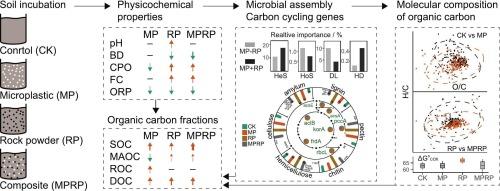岩石粉修正通过调节分子组成和微生物组合减轻微塑性引起的土壤有机碳不稳定
IF 6.6
1区 农林科学
Q1 SOIL SCIENCE
引用次数: 0
摘要
微塑料污染对土壤有机碳(SOC)的稳定性造成了严重威胁,而应用岩石粉增强风化作用是一种很有前途的固碳技术,可以通过矿物保护来提高土壤有机碳(SOC)。为了研究岩石粉对减轻微塑性引起的土壤退化的潜力,我们进行了四种处理的对照土壤柱试验:对照(CK)、微塑性(MP)、岩石粉(RP)和微塑性加岩石粉(MPRP)。我们分析了有机碳组分、分子组成、微生物多样性、碳循环功能基因和生态组装过程。MP处理显著降低了矿物伴生有机碳,改变了溶解有机碳组成,使其具有更高的芳香性和分子复杂性。RP改性有效地抵消了这些不利影响,MPRP处理显示出最高的SOC含量和增强的热力学稳定性。MP暴露显著改变了微生物群落组成,降低了多样性,而RP则维持了更接近CK的群落结构,提高了碳循环基因的丰度。生态过程分析表明,与MP处理相比,RP增加了异质性选择和均质化扩散过程。结构方程模型表明,土壤理化性质通过微生物群落和有机碳分子性质间接影响土壤有机碳含量。研究结果表明,石粉改良通过调节有机碳分子组成、微生物群落结构和生态组装过程,提高土壤有机碳含量和稳定性,有效缓解了微塑性引起的土壤退化。这为解决土壤中的微塑料污染提供了一个有希望的基于自然的解决方案,尽管潜在的环境和经济权衡需要进一步评估。本文章由计算机程序翻译,如有差异,请以英文原文为准。

Rock powder amendment mitigates microplastic induced destabilization of soil organic carbon by modulating molecular composition and microbial assembly
Microplastic contamination poses a significant threat to soil organic carbon (SOC) stability, while enhanced weathering via rock powder application is a promising carbon sequestration technology that enhances SOC through mineral protection. To investigate rock powder’s potential for mitigating microplastic-induced soil degradation, we conducted a controlled soil column experiment with four treatments: control (CK), microplastic (MP), rock powder (RP), and microplastic plus rock powder (MPRP). We analyzed SOC fractions, molecular composition, microbial diversity, carbon-cycling functional genes, and ecological assembly processes. MP treatment substantially decreased mineral-associated organic carbon and altered dissolved organic carbon composition toward higher aromaticity and molecular complexity. RP amendment effectively counteracted these adverse effects, with MPRP treatment showing the highest SOC content and enhanced thermodynamic stability. MP exposure significantly modified microbial community composition and reduced diversity, while RP maintained community structure closer to CK and enhanced carbon-cycling gene abundance. Ecological process analysis revealed that RP increased heterogeneous selection and and homogenizing dispersal processes compared to MP treatment. Structural equation modeling demonstrated that soil physicochemical properties influenced SOC indirectly through microbial communities and organic carbon molecular properties. These findings demonstrate that rock powder amendment effectively mitigates microplastic-induced soil degradation by enhancing SOC content and stability through modulating organic carbon molecular composition, microbial community structure, and ecological assembly processes. This provides a promising nature-based solution for addressing microplastic contamination in soils, though potential environmental and economic trade-offs require further evaluation.
求助全文
通过发布文献求助,成功后即可免费获取论文全文。
去求助
来源期刊

Geoderma
农林科学-土壤科学
CiteScore
11.80
自引率
6.60%
发文量
597
审稿时长
58 days
期刊介绍:
Geoderma - the global journal of soil science - welcomes authors, readers and soil research from all parts of the world, encourages worldwide soil studies, and embraces all aspects of soil science and its associated pedagogy. The journal particularly welcomes interdisciplinary work focusing on dynamic soil processes and functions across space and time.
 求助内容:
求助内容: 应助结果提醒方式:
应助结果提醒方式:


